#005
Plasticity and individual differences in
movement capability
Junichi Ushiyama
Japanese Color: TOKIWAMIDORI-iro
#005
Junichi Ushiyama
Japanese Color: TOKIWAMIDORI-iro
MOVIE
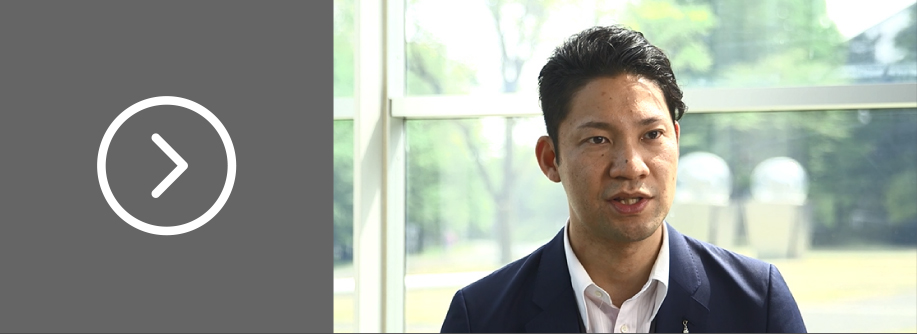
Associate Professor
Faculty of Environment and Information Studies
Why are there people who excel at sports and others who are poor at it, even when they attempt to perform the same exercise? What processes do first-class athletes go through to improve their performance?
If we were able to throw light on such questions by using a solid theoretical background and scientific methods, we would be able to make significant leaps forward in the field of sports, which has been mainly backed by empiricism. On top of that, we would also be able to contribute to the development of future rehabilitation treatment that matches the needs of individuals with movement disabilities.
The research undertaken by Associate Professor Junichi Ushiyama extends the logic that is created through fundamental research in neuroscience to applied areas such as sports science and rehabilitation medicine.
As an Associate Professor in the Faculty of Environment and Information Studies at Keio University, I am engaged in neuroscience research, in areas that are related to human movements and sensations. In addition, I also serve work concurrently as a Common Associate Professor in Keio University School of Medicine, where I am responsible for guiding research on rehabilitation medicine. I also conduct lectures on sports science for students.
Hence, as a researcher of fundamental science especially focused on exercise physiology, my fundamental idea is to enable the crossover of the three research areas of neuroscience, rehabilitation, and sports, in order to throw light on human movements.
My research aim is to capture the brain (nervous system) and body (muscular and skeletal systems) as one system, and examine how the two interact mutually while making adjustments for bodily movements from a cross-sectoral perspective. Going forward, my challenge is to extend the logic created through such fundamental research to applied areas such as sports science and rehabilitation medicine.
Of these, I believe that my contribution to the field of rehabilitation medicine lies in helping to create a future rehabilitation medicine that comes with solid theoretical background, by providing a quantitative and objective perspective to conventional, qualitative diagnostic and treatment methods.
Conversely, continuing to maintain a point of contact with rehabilitation medicine provides the advantage of making it easier to identify fundamental research themes that meet the needs of the modern society.
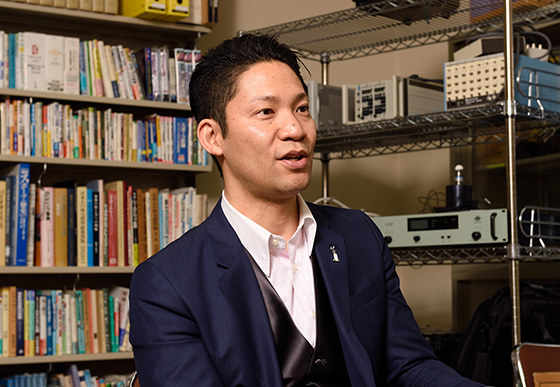
Among the research I have undertaken to date, I have measured electroencephalogram (EEG) (electrical signals of the brain), electromyogram (EMG) (electrical signals of the skeletal muscles), and motor output (muscle force) simultaneously when the participants performed motor tasks, and conducted analyses on the obtained data by using the programming language Matlab.
Especially, I have been evaluating the neural synchrony between the brain and contracting muscles. Such study is called “corticomuscular coherence” research. For example, even in an extremely simple single-joint movement such as performing a toe raise, the EEG and EMG patterns are in fact widely varied across individuals. While there are the ones whose EEG and EMG are synchronized very well, there are also the other ones whose EEG and EMG are not entirely synchronized.
The differing ways in which the brain and muscles interact among individuals would also have a significant impact on their motor performance. By capturing the brain and body as a system, I am attempting to elucidate the mechanism behind individual differences in motor performance, such as the stability of forces in movement.
Deriving further from this idea, I am also engaged in research relating to the difference in the motor abilities between athletes and common people, as well as the processes through which the same participant learns new motor tasks.
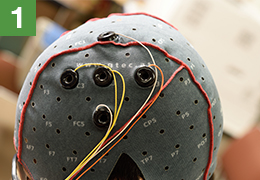
In the field of medicine, EEG is commonly measured while participants are at rest. However, in order to understand neural activity during exercise, the electrical signals of the brain and muscles are measured at the same time.
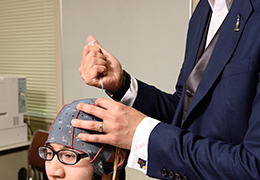
EEG is an extremely delicate signal, and is probably influenced by noise that comes from the experiment environment, such as the noise of fluorescent lights in the room. Hence, advanced preparation is carried out carefully, including cleaning of the scalp.
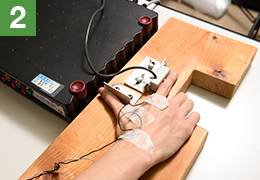
The activities of the muscles while the participant is in the process of exerting force are measured using EMG.
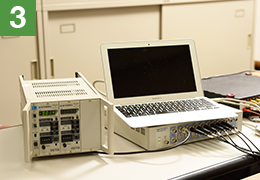
It is possible to shed light on the motor control mechanisms of the brain and body by measuring and analyzing the EEG and EMG when performing motor tasks.
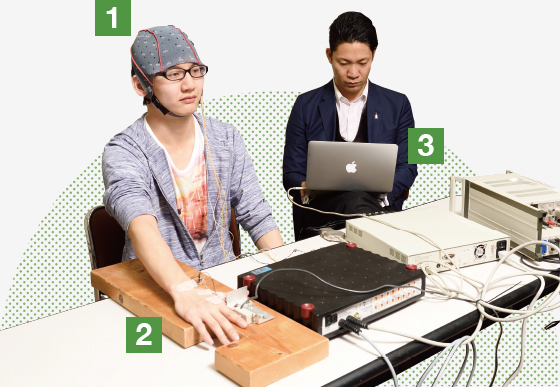
In my research, one of the keywords is “plasticity.”
Plasticity refers to how the body adapts to a given stimulus. For example, in order for persons to acquire skills through training, such as playing sports or some musical instruments, or for patients with movement disorders to recover their functionality through rehabilitation, how flexibly and dynamically does the brain and body system change its structure and functions? These are the questions that I am interested in.
From the perspective of a researcher of fundamental science who is focused on exercise physiology, when considering sports and rehabilitation based on the keyword of “plasticity,” I believe that some form of crossover takes place in that process.
The human body undergoes some form of internal changes by building up sports trainings. This is a type of plasticity that moves from “zero” to “plus.” On the other hand, bodily functions of patients with movement disorders would be recovered through rehabilitation. This could be described as another type of plasticity that moves from “minus” to “zero.”
Although these two forms of plasticity appear to be completely different, we may not be able to say so categorically. For example, those who gain bodily functions through daily sports experience undergo changes in the mechanisms of their brain and body as they raise the level of their physical ability and master motor skills. If they became disabled as a result of an injury or disease, they might be able to reduce the degree of their disability, or demonstrate greater rehabilitation efficiency than normal people, due to their bodily functions that have changed as a result of “plasticity” by many years of training.
By elucidating the mechanism of plasticity through science, I believe that it will also be possible to contribute to providing valuable findings to preventive medicine from the perspective of sports science.
A second keyword that I have adopted in my research is the “individual differences” in movement capability that exist among people.
This has been greatly influenced by my personal experiences. When I was a student, I was a member of the kendo club in the athletic association. Even though we practiced in the same way, I was keenly aware of the differences in the instinctive feel and athletic ability between myself and the top-notch athletes.
To understand the mechanisms of the fundamental differences between top-notch athletes and common people is an ultimate research aim that I would pursue throughout my life as a researcher.
In order to consider the problem of “individual differences,” rather than burying individual data in statistical processing, it is perhaps more important to carefully observe the individual cases, and clarify the underlying factors for these differences from a scientific perspective. This is a necessary and important perspective in thinking about sports science and rehabilitation medicine.
Furthermore, in the research area of motor control in neuroscience, scientific values are more often uncovered in fundamental research that use monkeys than human beings as test subjects. However, I believe that there are angles that we are able to uncover only when human beings are used as the test subject. One of these is my focus on individual differences.
It is my unique characteristic to engage in cross-sectoral research through light footwork, even as I place my focus on the three research areas of neuroscience, sports science, and rehabilitation medicine. I am a graduate of the Shonan Fujisawa Campus of Keio University (SFC), and I feel that the open academic culture that is unique to SFC played a significant role in nurturing this quality in me.
Junichi Ushiyama laboratory at SFC is currently engaged in research on the rehabilitation of stroke patients with movement disorders, together with the students and in collaboration with the university’s School of Medicine.
As my future goal, I aim to take up the challenge of engaging in research that reconsiders the value of “movement” itself, through the mutual interaction and sharing of information across fundamental exercise physiology, neuroscience, rehabilitation medicine, and sports science research.
While society is becoming increasingly convenient, I feel that this convenience has the risks of developing a society that enables us to survive even if we do not move our bodies. It is my wish to contribute as a researcher to ensure that the human body does not degenerate in exchange for a convenient lifestyle.
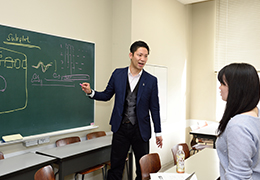
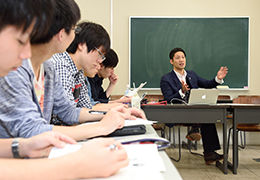
Junichi Ushiyama laboratory has undertaken countless experiments, reading papers on neuroscience in turn and studying analytical methods, based on the motto that “the more you sweat, the more results you produce.”

Junichi Ushiyama
Associate Professor, Faculty of Environment and Information Studies, Keio University and holding additional position at Keio University School of Medicine(Rehabilitation Medicine). Ph.D, in Life sciences (Graduate School of Arts and Sciences, The University of Tokyo). Ph.D. in medicine (Keio University School of Medicine). Specializes in exercise physiology and neurophysiology. Has published numerous papers on corticomuscular coherence research, which combines EEG and EMG and looks at their mutual communication.
(Japanese Only)https://www.facebook.com/Junichi.Ushiyama.Lab

2015.aug.ISSUE